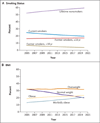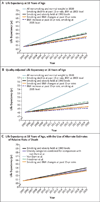Forecasting the effects of obesity and smoking on U.S. life expectancy
- PMID: 19955525
- PMCID: PMC4394736
- DOI: 10.1056/NEJMsa0900459
Forecasting the effects of obesity and smoking on U.S. life expectancy
Abstract
Background: Although increases in obesity over the past 30 years have adversely affected the health of the U.S. population, there have been concomitant improvements in health because of reductions in smoking. Having a better understanding of the joint effects of these trends on longevity and quality of life will facilitate more efficient targeting of health care resources.
Methods: For each year from 2005 through 2020, we forecasted life expectancy and quality-adjusted life expectancy for a representative 18-year-old, assuming a continuation of past trends in smoking (based on data from the National Health Interview Survey for 1978 through 1979, 1990 through 1991, 1999 through 2001, and 2004 through 2006) and past trends in body-mass index (BMI) (based on data from the National Health and Nutrition Examination Survey for 1971 through 1975, 1988 through 1994, 1999 through 2002, and 2003 through 2006). The 2003 Medical Expenditure Panel Survey was used to examine the effects of smoking and BMI on health-related quality of life.
Results: The negative effects of increasing BMI overwhelmed the positive effects of declines in smoking in multiple scenarios. In the base case, increases in the remaining life expectancy of a typical 18-year-old are held back by 0.71 years or 0.91 quality-adjusted years between 2005 and 2020. If all U.S. adults became nonsmokers of normal weight by 2020, we forecast that the life expectancy of an 18-year-old would increase by 3.76 life-years or 5.16 quality-adjusted years.
Conclusions: If past obesity trends continue unchecked, the negative effects on the health of the U.S. population will increasingly outweigh the positive effects gained from declining smoking rates. Failure to address continued increases in obesity could result in an erosion of the pattern of steady gains in health observed since early in the 20th century.
2009 Massachusetts Medical Society
Conflict of interest statement
No potential conflict of interest relevant to this article was reported.
Figures


Comment in
-
Effects of obesity and smoking on U.S. life expectancy.N Engl J Med. 2010 Mar 4;362(9):855-6; author reply 856-7. doi: 10.1056/NEJMc1000079. N Engl J Med. 2010. PMID: 20200394 No abstract available.
References
-
- Mokdad AH, Marks JS, Stroup DF, Gerberding JL. Actual causes of death in the United States, 2000. JAMA. 2004;291:1238–1245. - PubMed
-
- Idem. Correction: actual causes of death in the United States, 2000. JAMA. 2005;293:293–294. - PubMed
-
- Flegal KM, Graubard BI, Williamson DF, Gail MH. Excess deaths associated with underweight, overweight, and obesity. JAMA. 2005;293:1861–1867. - PubMed
-
- Allison DB, Fontaine KR, Manson JE, Stevens J, VanItallie TB. Annual deaths attributable to obesity in the United States. JAMA. 1999;282:1530–1538. - PubMed
-
- Manson JE, Bassuk SS, Hu FB, Stampfer MJ, Colditz GA, Willett WC. Estimating the number of deaths due to obesity: can the divergent findings be reconciled? J Womens Health (Larchmt) 2007;16:168–176. - PubMed
Publication types
MeSH terms
Grants and funding
LinkOut - more resources
Full Text Sources
Medical
Miscellaneous
